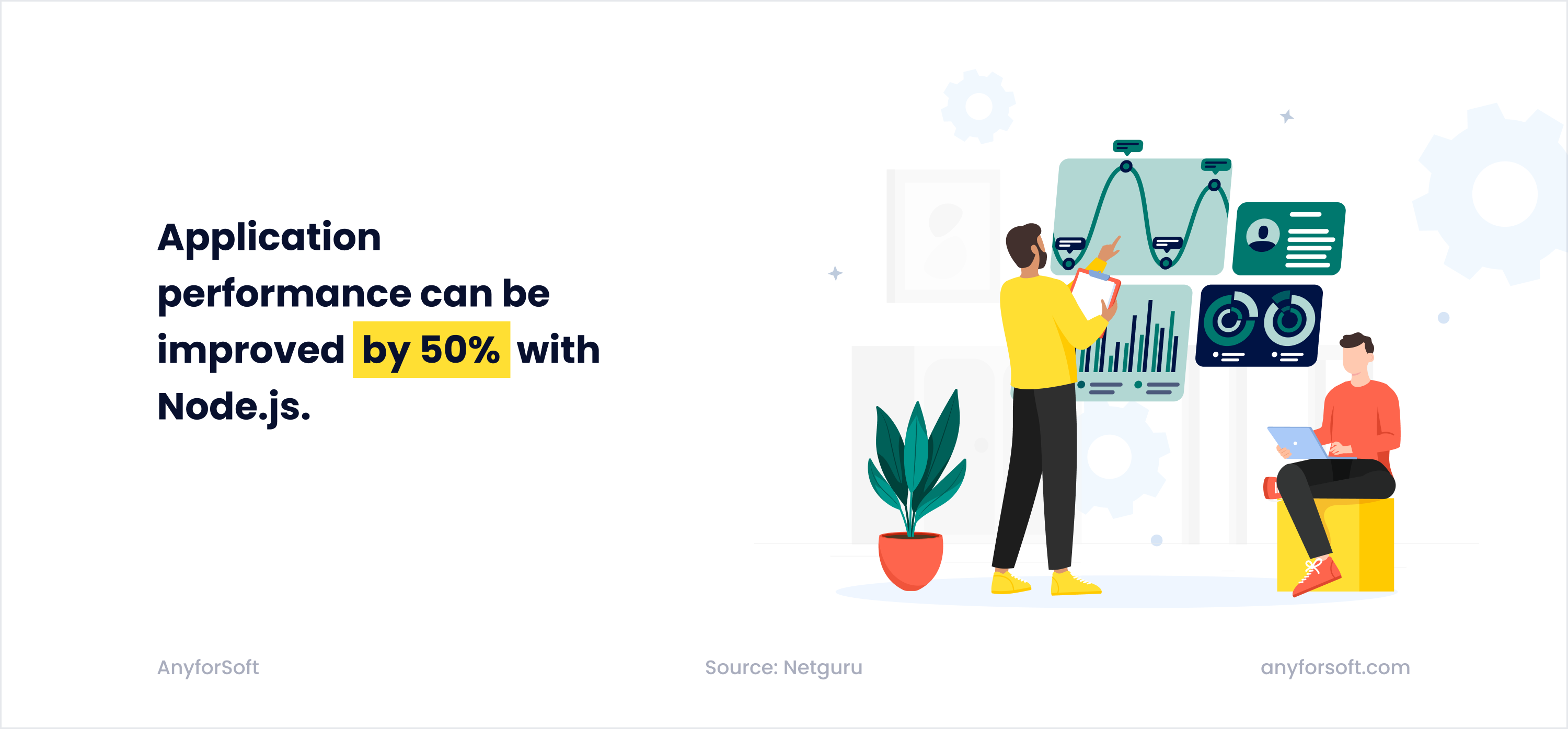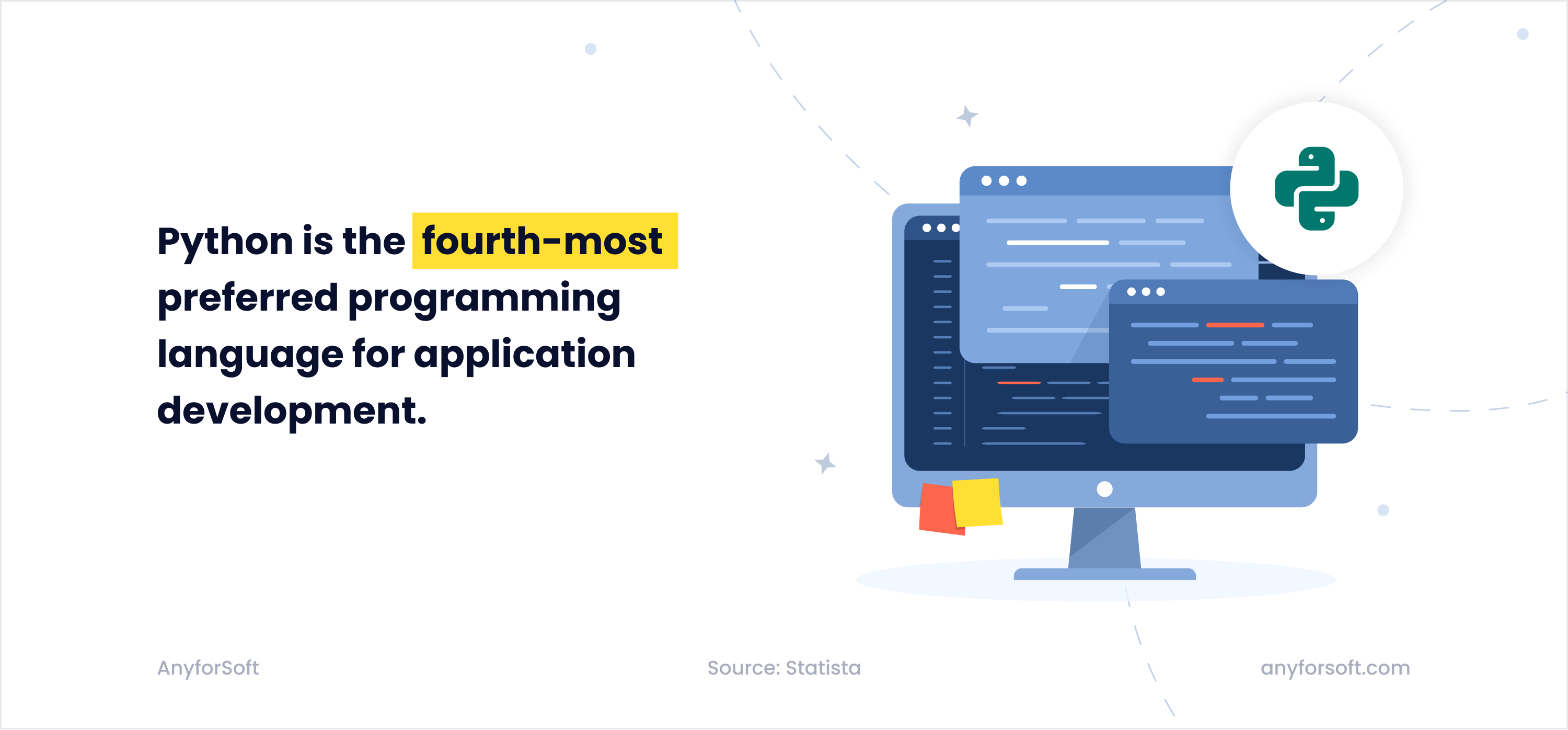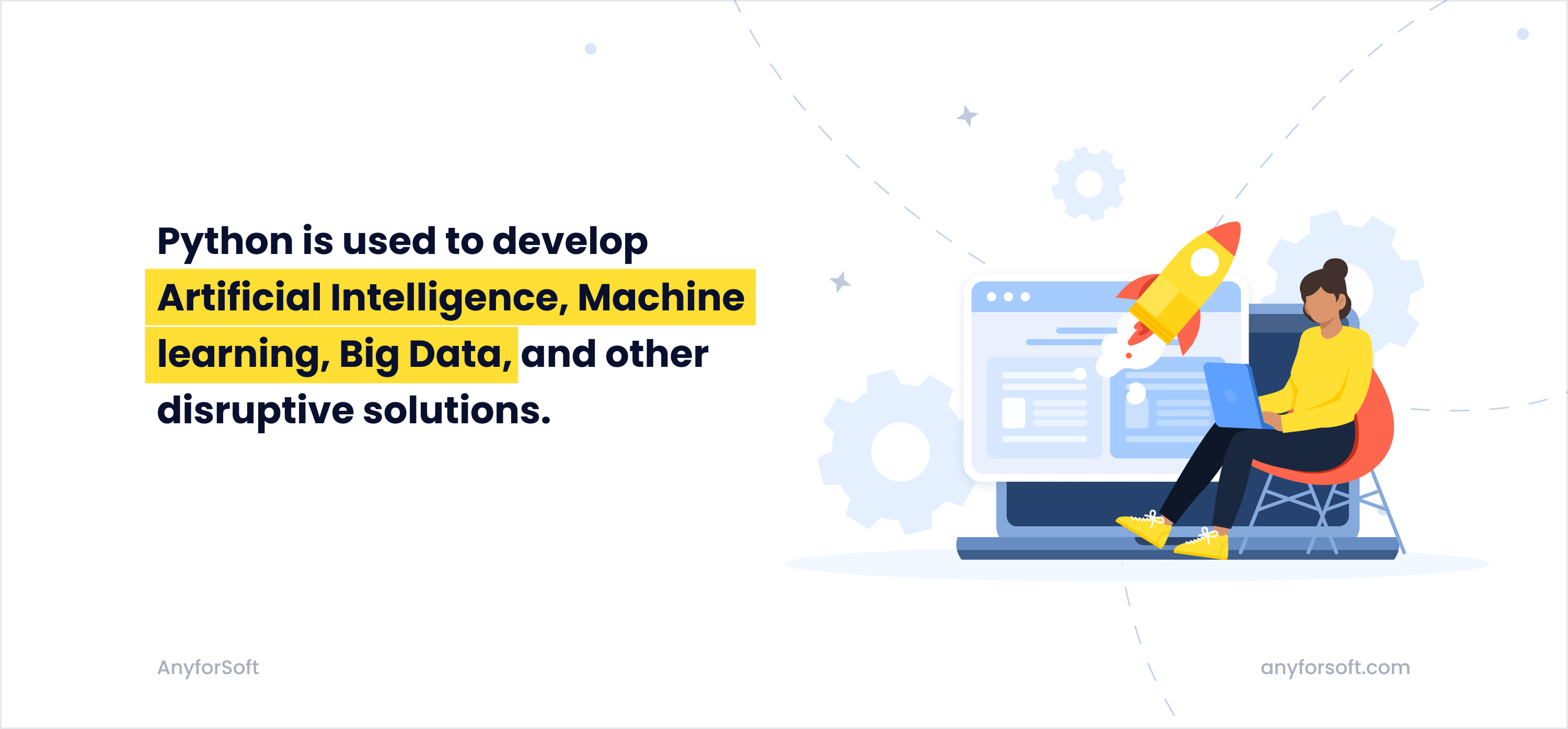Striving to build stable and well-balanced applications and web pages, one should be cautious while choosing a programming language for successful web development. Of course, there are leading technologies that underlie top digital products, but is this the primary criterion for selecting technologies directly for your project?
What deserves your attention is speed, performance, flexibility, functionality, and availability. No matter how attractive the design is and how well-thought-out the usability is, precisely how stable, smooth, and seamless the application or website works will determine whether your customer will stay with you or bring new ones. Let's discuss two promising and fairly common programming languages and compare Node.js vs. Python to decide which will best implement your idea.
Overview of Node.js and Python
You might hear that there is no perfect or best programming language for backend development; however, there are technologies that fit your purposes and needs. And comparing Node.js and Python, we're trying to draw the lines to follow in particular cases. Flexible and scalable web development requires a multipurpose programming language, so let's explore two of them.
Node.js
We will start with the correct terms. Node.js is not a programming language in common sense. It is a JavaScript runtime environment with multiple modules. It runs on Google's engine V8, making it one of the most often chosen backend technology for web applications for the last few years.
It is a cross-platform solution allowing to build of web apps for different operating systems at once, reducing time to market and saving budget on web app development.
Strong Google and large community support make it possible to solve any complex issue and implement the most comprehensive ideas and projects.
Node.js Features
Broad functionality is crucial for web development, especially for growing and niche products requiring updates and improvements. Node.js can offer lots of advantageous options to enhance your web applications.
- Implemented in JavaScript. As mentioned before, Node.js is a runtime environment of JavaScript that makes it possible to build the whole project with only JavaScript tech since it is also used for front-end development. Moreover, developers can easily extend their knowledge and skills.
- Has asynchronous nature. Asynchronous programming allows for providing a better user experience and reduces response time. It is granted through non-blocking I/O and asynchronous architecture. In general, with Node.js as backend technology, you'll never need to wait for data from API.
- Has event-driven architecture. The event-based architecture is responsible for the app's lightweight and seamless operation. Once that task – or event – is completed, the callback function is executed. It requires fewer resources and memory.
- Single-Threaded. All tasks are collected in an event loop and executed in one thread, as can be understood from the name. It prevents reloading and makes the Node-based applications more comfortable to use since they won't take all the free memory.
- Scalability. Node.js was developed for highly scalable and customizable programming, thus bringing the software project the most valuable solutions.
- Quick Data Streaming. When it comes to Data Streaming, speed is highly significant. The Google V8 engine allows Node.js to meet all possible requirements.
- Minimum Buffering. Node.js provides zero buffering as it works with chucked data streams, which leads to a seamless and smooth user experience.

Node.js is an attractive solution for almost any project. If you are ready to choose Node.js vs. Python, wait until we show you Python.
Python
Python is an object-oriented, robust programming language. It is recognized that Python's syntax, dynamic typing, and interpreter make it one of the best-fitted solutions for scripting.
Both Python and Node.js are interpreted languages, meaning you'll have to run them in runtime to convert them to computer-readable code. That makes them slower than, for example, compiled languages but still pretty fast for general tasks. However, Python runs on Google's app engine, which makes it stable and reliable but less fast and responsive than Node.js.
Python also has a 30-year history of application and web development. It provides scalable and fast development capabilities. Many experienced Python developers prefer robust and time-trusted Python-based solutions for complex and feature-rich projects.
Python Features
The reusability of Python code ensures its purity, simplicity, flexibility, and efficiency. However, this is only some of this programming language offers for backend development.
- Easy to code and read. Most of the functions are one-line. That makes Python a perfect programming language to learn and code. While some complex and challenging issues may require more profound knowledge, the basis already allows the creation of simple web applications.
- GUI support. There are many GUI that can be easily added to Python interpreter. Graphical User Interface adds a little extra to the coding process, making the result more visual. It can be a key to faster coding and debugging.
- Object-oriented. It was mentioned before, and it means that Python is keen to object encapsulation, making it efficient and reliable.
- Feature-oriented. While everyone is crazy about AI and neural networks, Machine Learning transform businesses taking them to a new level. Python works well for new solutions development as it is the basis of most now-known Machine Learning offerings.
- High-Level. Python programming language is simple and flexible. Don't bother about structure or architecture, just code.
- Data science compatible. As devices store more and more information, the importance of data analytics grows. Python is one of the best choices for large projects in the long run.
- Integrated. Python's flexibility is not only in the coding but with integrations. It can be integrated with compelled and interpreted languages and web frameworks.
Comparing Node.js vs. Python, they can give necessary options and stability to server-side development. So the main question is in purpose and priorities.
Detailed Comparison Of Node.Js Vs. Python Backend Technologies
By Analyzing Python and Node.js, you can highlight both common features and differences. The main characteristics will determine whether this or that technology suits you, so decide on the key points that play an essential role in your product to pay special attention to them.
Briefly about the main differences. As you know, Node.js is a newer technology and has not yet fully revealed its potential because there are constantly new ways of using it. Meanwhile, Python, having a long time since its release til the present, can solve highly complex tasks related to AI, Big Data solutions, IoT solutions, process automation, backend development, and others.
Not being a programming language but a JavaScript environment, Node.js allows the creation of harmonious cross-platform solutions because JavaScript is actually used for the backend and front-end. Python is more suitable for complex products that focus not on speed but on reliability, such as desktop and web applications.
Performance
One of the whales on which there is quality and modern web development is performance. Without high performance, imagining a successful and progressive product is difficult. Comparing Node.js vs. Python performance, it is enough to remember that the Node launches on a Google V8 engine – which provides high responsiveness and indicators.

However, Python, as a single-threaded language with innate architecture, has some limitations, making its performance lower than Node.js' performance.
Speed
Node.js vs. Python speed is one more important category to consider. In short, since Node.js uses JavaScript and runs with V8, its speed is also higher. Moreover, it executes the code outside the browser offering access to some extensive options and allowing for more resource efficiency.
Due to their structural and operational restrictions, Python processes are slower and therefore lose new technology in this race. However, using Python, you can create complex programs without fast calculations and servers.
Scalability
Scalability is worth agreeing on the shore -- before the software development because the possibility of growth and expansion of functionality of the finished product will depend on it. And again, the first place goes to Node.js. In this case, scalability is provided by module bundling, which is easy and fast and allows the app to remain lightweight and straightforward to use. It also supports multithreading and asynchronous code, additionally contributing to flexibility.
While Python is dynamically typed and can be extended with many useful libraries and tools, it still can't be as convenient as Node. Unfortunately, large Python-based systems will eventually become difficult to maintain.
Architecture
That's where the characteristics of technologists are revealed most. The event-driven Node.js with multi-threading and asynchronous architecture process several requests at a time, making it almost ideal for web games, chats of bots, and real-time applications.
While Python is synchronous and does not allow many micro-service options, although additional libraries and a means can fix it, it is not a very elegant solution.
And again, Node.js vs. Python, the first gets the point.
Extensibility & Universality
This indicator demonstrates how friendly technology is to spread and integrate with other frameworks and modules. And they have a particular satellite, which is widely used and allows the web development process to be light, simple, and comprehensive; just choose the necessary additional elements from the tech stack.
As well as universality: Python and Node.js are suitable for front-end and backend web development and can be used for many purposes and applications of different kinds.

Libraries & Tools
Modern web development is becoming time-efficient and simpler thanks to libraries and tools. A wide range of accessible frameworks and other tools allows us to reduce development time and fasten time to market, apply ready-made solitons, etc. And if you try to decide which technology has more available libraries, Node.js or Python, then it is not the quantity but their functionality.
Node.js uses a Node package manager, which installation opens access to a vast number of packages and one of the largest repositories.
As for Python, thirty years of existence and active use are collected in Pips installs Python, simple, reliable, and fast.
Learning Curve and Syntax
This parameter is an essential component of studying technology and its use. The more complex the language, the longer you need to learn its features and the more practice you need to use it correctly. In addition, complex or simple syntax determines how clean or curly the resulting code will be.
When choosing Node.js or Python to study, it is easier for a beginner to learn Python. The basics are learned very quickly, and individual elements take some time, but not much. Python needs fewer lines of code to describe functions, significantly speeding up coding.
While Node.js is easy for those who already know JavaScript, learning it from scratch can be difficult due to its architecture and syntax.
Error Handling
When it comes to troubleshooting, it's crucial to have reliable tools that ensure clean code and the ability to find and fix a bug quickly. Node.js and Python have it all; however, it is Node.js that loses here.
By supporting multithreading and processing multiple requests at the same time, Node simultaneously improves performance and makes debugging more difficult.
While Python, in the absence of these features, makes finding and fixing errors a simple and easy process.
So, to choose Python or Node.js, you already have specific characteristics of the backend solutions, and you can decide which of them are vital for you and which can be omitted. However, this is still not all. Let's look at technology use cases to make up our minds.
When to use Node.js?
Based on the features and advantages of the runtime environment, you can conclude the industries or areas of application of Node.js. High speed and performance make it suitable for real-time applications, such as large and small streaming platforms or online stores, where a large number of requests must be processed simultaneously.
Node.js will come in handy when developing games and powerful 3D graphics, where it is essential to ensure speed and a high-quality user experience.
One of the most common ways of using Node is microservices and chatbots, which are light, flexible, and customizable.
Among the biggest fans of technology are LinkedIn, Tumblr, PayPal, Uber, and Netflix.
When to use Python?
We have found that Python is not fast enough and high-performance to create web applications that require these features; however, this does not mean that the programming language will not be helpful in today's digital world.
With a long life span and vast application areas, Python is still the guardian of the latest digital solutions. Developers use Python to provide testing automation, Artificial Intelligence, Big data, and others.
Thanks to its stability and reliability, Python has earned the respect of government institutions and is used in many government projects and the creation of data science apps.

Companies that prefer Python: Nasa, Reddit, Facebook, Google, Instagram, Quora, and Spotify.
With broad community support, Node.js and Python can solve comprehensive issues and meet challenging tasks during software development.
Summary: Which One Technology Should You Pick?

When comparing Node.js vs. Python, there is no clear or short answer as to which technology will be the breakthrough for your project. After a broad review and detailed analysis of individual features, it should be clear what each of them is capable of. Still, the final decision will be made only after the project is evaluated.
Python vs. Node.js comparison showed that they have a lot in common, but each has different strengths, which makes them popular for use in seemingly opposite fields. Still can't decide? Contact our manager, and he will advise you on the choice of backend technology and provide a team that cares about the final result to ensure the best possible implementation of your idea.
